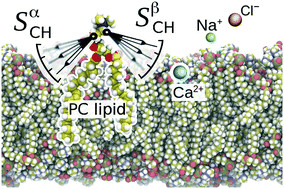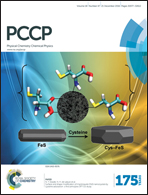Molecular electrometer and binding of cations to phospholipid bilayers†
Abstract
Despite the vast amount of experimental and theoretical studies on the binding affinity of cations – especially the biologically relevant Na+ and Ca2+ – for phospholipid bilayers, there is no consensus in the literature. Here we show that by interpreting changes in the choline headgroup order parameters according to the ‘molecular electrometer’ concept [Seelig et al., Biochemistry, 1987, 26, 7535], one can directly compare the ion binding affinities between simulations and experiments. Our findings strongly support the view that in contrast to Ca2+ and other multivalent ions, Na+ and other monovalent ions (except Li+) do not specifically bind to phosphatidylcholine lipid bilayers at sub-molar concentrations. However, the Na+ binding affinity was overestimated by several molecular dynamics simulation models, resulting in artificially positively charged bilayers and exaggerated structural effects in the lipid headgroups. While qualitatively correct headgroup order parameter response was observed with Ca2+ binding in all the tested models, no model had sufficient quantitative accuracy to interpret the Ca2+:lipid stoichiometry or the induced atomistic resolution structural changes. All scientific contributions to this open collaboration work were made publicly, using nmrlipids.blogspot.fi as the main communication platform.



 Please wait while we load your content...
Please wait while we load your content...